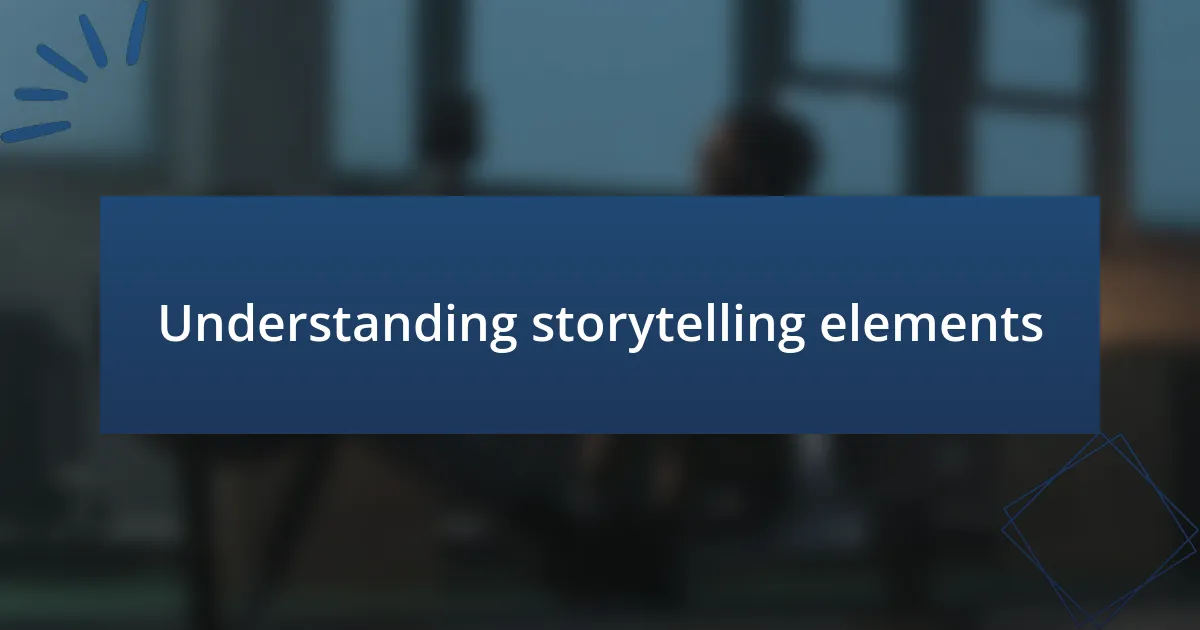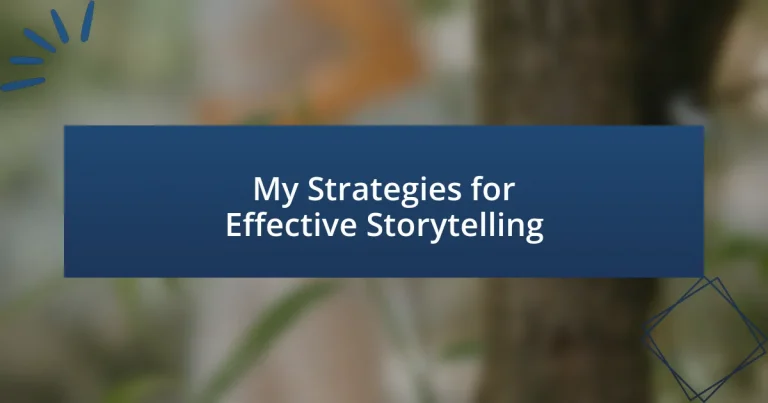Key takeaways:
- Emotional connection is crucial in storytelling; relatable characters and conflict engage readers deeply.
- Effective storytelling includes a clear structure with a strong beginning, layered plots, and a reflective conclusion.
- Utilizing sensory details can create immersive experiences, making readers feel the emotions and environments vividly.
- Active listening and continuous feedback enhance storytelling style and help refine one’s unique voice.

Understanding storytelling elements
At its core, storytelling is about connecting with emotions. I remember the first time I truly felt the power of a story—it was a heartfelt narrative about loss and redemption that left me in tears. This emotional resonance often stems from relatable characters; when readers see bits of themselves in the character’s struggles or triumphs, they become invested.
Another key element is the narrative structure. Think about the last book or movie that hooked you; it likely followed a classic arc, with a clear beginning, middle, and end. By organizing your tale in this way, you guide your audience through a journey, allowing them to experience the highs and lows alongside your characters. Have you ever filled in the gaps of a story in your mind, imagining what might happen next? That curiosity is part of what keeps us engaged.
Conflict is equally important in storytelling. Without it, what’s there to stir emotions or drive the plot forward? In my own writing, I often incorporate conflict to create tension. I’ve noticed that when I pit my characters against obstacles—be it external challenges or internal struggles—their development becomes richer and more compelling. How can your story thrive if there’s nothing for your characters to overcome? This tension not only adds depth but also compels readers to turn the page, eager to see how it all unfolds.

Crafting relatable characters
Crafting relatable characters is essential for engaging your audience. In my experience, characters resonate best when they embody real human flaws and strengths. I once created a character with anxiety, drawing from my own experiences. This depth allowed readers to connect, as many have faced their own struggles with self-doubt. When characters face relatable challenges, it allows us to reflect on our own lives, which is incredibly powerful.
To ensure your characters feel authentic, consider these strategies:
– Give them flaws: No one is perfect, and characters shouldn’t be either. Flaws create depth and relatability.
– Show their growth: Characters should evolve through the story. Witnessing their progress mirrors our own life journeys.
– Create backstories: Understanding their past can explain their current behaviors and choices.
– Exploit emotions: Tap into universal feelings, like love, fear, and joy, which everyone can relate to.
– Incorporate quirks: Unique traits or habits make characters memorable and real.
By focusing on these elements, your characters will not only be relatable but will also linger in the minds of readers long after they’ve finished your story.

Building a compelling narrative
Building a compelling narrative requires a clear structure that guides the reader through the story. I find that a strong beginning captures attention immediately—think gripping hooks or intriguing questions that leave the audience wanting more. I’ve often reflected on the power of an opening scene; for instance, introducing a character in a moment of crisis can instantly create urgency and emotional investment.
As the story unfolds, layering subplots can significantly enhance the main narrative. These threads don’t just fill space; they enrich character development and thematic depth. I recall a time I wove a subplot about family dynamics which not only reflected my protagonist’s internal struggles but also resonated with readers who recognized those same conflicts in their own lives. It’s fascinating how weaving together these threads can elevate a simple tale into a profound exploration of life.
Finally, the conclusion is your chance to leave a lasting impression. A well-crafted ending should provide resolution while also inviting reflection, akin to a gentle nudge that the story lingers on. Personally, I cherish conclusions that echo the initial themes, creating a satisfying circularity that feels intentional and gratifying for the reader.
| Element | Description |
|---|---|
| Beginning | Engage with a strong hook or question to capture attention. |
| Plot Layers | Incorporate subplots to enhance character and theme development. |
| Conclusion | Provide resolution and invite reflection, creating a sense of completeness. |

Utilizing imagery and sensory details
Utilizing imagery and sensory details can truly set your story apart. I remember a scene I wrote where I described a bustling market filled with vibrant colors and intoxicating aromas. The way the spices mingled in the air seemed to pull readers into that moment, making them feel as if they were right there, experiencing it alongside the characters. This kind of vivid imagery not only paints a picture but also evokes feelings that resonate deeply.
I often ask myself: how can I make my readers feel, taste, or hear what my characters are experiencing? One technique I frequently use is tapping into the senses. For example, when I crafted a rainy scene, I didn’t just mention that it was raining; I described the sound of raindrops tapping on the window and the fresh scent of wet earth. These details help create an immersive experience that draws readers in, allowing them to connect with the narrative on a sensory level.
Lighting is another layer I find crucial in creating imagery. Think about how the soft glow of candlelight can evoke warmth and intimacy in a scene. I once wrote about a romantic dinner under candlelight, detailing how the flickering flames danced and cast playful shadows on the walls. This attention to detail not only sets the mood but also carries emotional weight, making the reader feel the pulse of the moment. What emotions do you want to evoke in your readers? By utilizing sensory details, you can build that emotional bridge effortlessly.

Engaging the audience emotionally
One of the most effective ways I’ve found to engage an audience emotionally is through relatability. When I wrote about a character grappling with loss, I poured my own experiences into their journey. I found that sharing specific moments—like the aching silence in an empty room—resonated deeply with readers who might have faced similar feelings. Isn’t it fascinating how a shared experience can create an immediate connection, making the story feel like a personal conversation rather than just words on a page?
I always think about how pivotal emotions are in storytelling. During one of my writing workshops, I had participants read a passage featuring a character overwhelmed by joy. The smiles and laughter in the room were palpable, proving that joy can be contagious. I believe that crafting moments that evoke laughter or tears can lead readers to not just witness the emotions, but to feel them as if they were their own.
Building relatable characters adds another layer of emotional depth. I remember creating a character who struggled with self-doubt—a feeling I can link to my own journey. By illustrating their insecurities, I encouraged readers to see their own reflections within the story. Have you ever rooted for a character simply because you understood their fears? This connection reinforces empathy, pulling readers deeper into the narrative and leaving a lasting impression long after they finish reading.

Practicing active listening techniques
Active listening is more than just hearing words; it’s about being fully present in the moment. I remember a time during a group discussion when I practiced this technique. Instead of formulating my response while others were speaking, I focused intently on their narratives. This shift not only deepened my understanding but allowed me to respond more thoughtfully, leading to richer storytelling for everyone involved.
One of the active listening techniques I often utilize is summarizing what I’ve heard. During a brainstorming session, I noticed that when I paraphrased others’ ideas, it encouraged them to elaborate and refine their thoughts. It felt rewarding to witness how my attentiveness fostered an inclusive environment, where each voice mattered. Have you ever felt encouraged to share more when someone truly listened to you?
Asking open-ended questions is another powerful tool in my active listening arsenal. I recall a workshop where participants shared their stories, and I interjected with questions like, “What inspired that moment in your story?” This approach invited deeper conversations, sparking connections that enriched the storytelling experience. It made me realize how, as listeners, we have the ability to unlock layers within others’ narratives simply by expressing genuine curiosity.

Refining your storytelling style
Refining your storytelling style requires introspection and a willingness to explore your unique voice. I recall my own journey of experimenting with different tones and formats. Initially, I found myself imitating popular styles, but the magic happened when I allowed my authentic self to shine through. Have you ever tried shedding the layers of influence to discover what resonates most with you?
One key aspect for me was the use of imagery and descriptive language. I remember sharing a personal experience that involved a camping trip, and I focused on painting the scene—the feel of the cool breeze, the crackling of the fire, and the laughter of friends under a starlit sky. This vivid storytelling not only captured my audience’s attention but created a shared experience. Isn’t it fascinating how sensory details can transport listeners into a different world?
Continuous feedback is invaluable in this refinement process. I sought input from trusted friends after sharing my stories. Their reactions taught me about the emotional triggers within my narratives, making me more aware of which elements truly resonated. This iterative process of storytelling reminded me that storytelling is a craft shaped not just by our intentions but also by how our messages are received.





